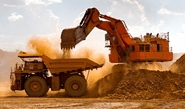Steel Markets

Steel Tariffs Cost Caterpillar $70 Million in First Quarter
Written by Sandy Williams
April 27, 2019
Caterpillar manufacturing costs escalated in first quarter by $375 million compared to a year ago on higher steel prices, freight and variable labor costs.
“These higher costs, while unfavorable, were improved from the fourth quarter levels. Material costs included a direct tariff expense in the first quarter of about $70 million, in line with what we expected,” said CFO Andrew Bonfield during the company’s first quarter 2019 earnings call. “Remember tariffs only started in July of last year, so these will have an impact in Q1 and Q2 until we are past their original implementation date.”
Caterpillar expects lower steel prices this year that will help bring down costs.
Construction sales increased in North America by $345 million due to higher demand for new equipment, particularly for road construction activities.
“We continue to believe that the healthy U.S. economy, along with stable local funding for infrastructure development will be a positive for us, partly offset by weakness in residential construction,” said Chairman and CEO James Umpleby.
In the energy sector, volatility in oil prices and pipeline takeaway capacity in the Permian are impacting demand for well servicing equipment in the first half of the year, said Umpleby. Demand is expected to pick up as pipeline constraints in the U.S. ease later this year. Gas compression should remain healthy.
Caterpillar and its customers are “cautiously optimistic” while working their way through trade issues.
“Certainly, anytime there are trade tensions of this kind. It does put a certain amount of conservatism, I think, into all of our plans for capital spending,” said Umpleby. “So, I would expect if, in fact, the trade tension gets resolved, that would be a positive for global economic growth and positive for us.
Caterpillar sales and revenues for the quarter totaled $13.5 billion, up 5 percent from last year, driven by both volume gains and price realization. North American sales, led by the construction segment, rose 7 percent year-over-year to $6 billion.
First quarter 2019 profits were a record $1.88 billion, up 13 percent from Q1 2018.

Sandy Williams
Read more from Sandy WilliamsLatest in Steel Markets

CMC looks beyond Arizona micro-mill woes to long-term viability of construction mart
Despite the economic and geopolitical upheaval of the last five years, CMC President and CEO Peter Matt points out that the construction market has been an essential element of the way forward.

US importers face stricter rules under revamped S232 tariffs
“CBP expects full compliance from the trade community for accurate reporting and payment of the additional duties. CBP will take enforcement action on non-compliance," the agency said in a March 7 bulletin.

Steel exports rebound in January
US steel exports recovered to a five-month high in January after having fallen to a two-year low in December. This growth follows four consecutive months of declining exports.

Construction spending drops marginally in January
Construction spending edged down slightly in January, slipping for the first time in four months. The US Census Bureau estimated spending at a seasonally adjusted annual rate of $2,196 billion in January, down 0.2% from December’s downward revised rate. The January figure is 3.3% higher than a year ago. January’s result, despite the slight erosion, […]

HVAC equipment shipments slow in December but strong annually
Shipments of heating and cooling equipment in the US fell to an 11-month low in December, according to the latest data released by the Air-Conditioning, Heating, and Refrigeration Institute (AHRI).
